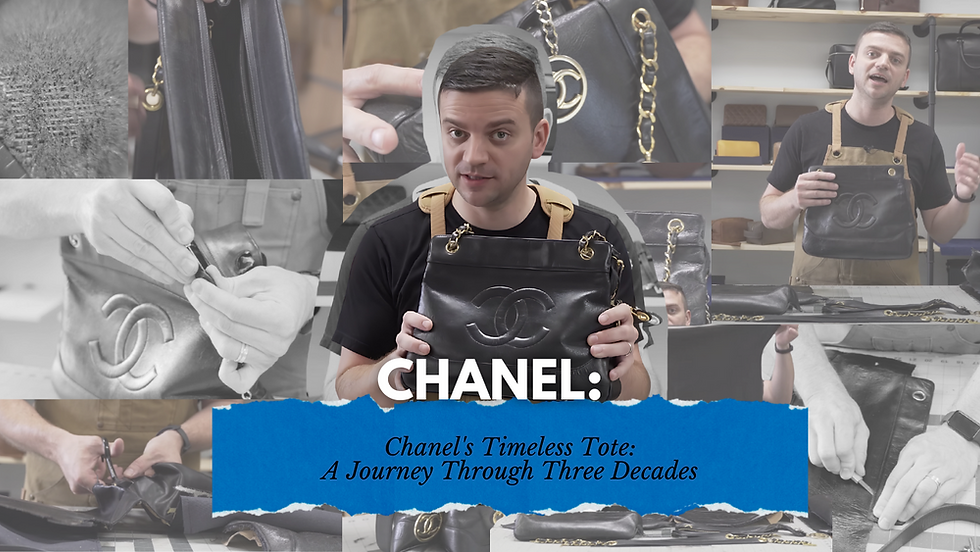
TABLE OF CONTENTS
BRIEF HISTORY
Chanel is a luxury fashion house founded in 1910 by Coco Chanel in Paris and has been headquartered in London since 2018. Privately owned by the Wertheimer family, Chanel specializes in women's ready-to-wear, luxury goods, and accessories, and licenses its name to Luxottica for eyewear. The brand is renowned for its No. 5 perfume and the iconic "Chanel Suit." Chanel revolutionized haute couture and ready-to-wear fashion by replacing structured, corseted silhouettes with more functional yet flattering garments.
Brand Website: chanel.com
AUDIENCE & CUSTOMER'S PERSPECTIVE
How would you rate Chanel as a brand?
How would you rate Chanel as a brand?
5
4
3
2
PRODUCTS REVIEWED
Chanel's Timeless Tote: A Journey Through Three Decades
Chanel's Timeless Tote
Watch the videos here:

Today, we have a special treat courtesy of Luxury Leather Guys, a reputable pre-loved luxury goods seller. They sent us a vintage Chanel Timeless Tote Bag in black lambskin for an independent review. This bag, approximately 30 years old, showcases both the timeless elegance and craftsmanship Chanel is known for. Let’s dive in and see how it holds up after three decades.
DISCLAIMER: The mentioned brand sent this product for FREE. However, we are NOT PAID to do this review. All statements and expressions made about the products are Tanner Leatherstein’s independent review. The brand did not get to see the final video until it was published live. They also agreed to our terms and conditions that we will post our honest review about the brand and/or product and that we might disagree with the information provided in their shop or website.
Tanner Leatherstein’s reviews are not meant to be conclusive or definitive. The purpose of this video is for informational and educational purposes only. We recommend that as a consumer, you exercise your due diligence and research on the products before adopting the opinion of Tanner Leatherstein.
First Impressions: The Exterior
The first thing that stands out is how well the lambskin has held up. Lambskin is known for its delicate nature, yet the flat surfaces of this bag remain impressively intact. There is some expected crackling on the folded areas, but overall, it’s in great shape for its age. The craftsmanship is evident in the absence of edge paint; instead, all edges are folded, which enhances durability.
Craftsmanship and Durability
One of the highlights of this bag is its construction. The accessories, including the iconic Chanel hardware, are still functional and in good shape. The interior boasts a complete leather lining, adding to the bag’s luxurious feel. Despite being lambskin, the scratch resistance is noteworthy. I tested it with my fingernails, and it showed only minor residue when scratched hard—impressive for such a delicate material.
Detailed Examination: The Interior
When we stripped away the top layer from this lambskin, the true essence of its grain revealed itself. For a piece that's been around for 30 years, this lambskin is holding up remarkably well. The finish, a typical pigment layer common in lambskin goods, is quite minimal. However, the age has taken its toll—where the design curves and bends, the pigment has cracked and loosened, a sign of the plastic layer drying out over time.
Despite the outer lambskin's high quality, we discovered something less savory inside. What appeared to be a luxurious gold lining was, in fact, PU leather. The entire interior is made of this synthetic material, which can be misleading. When the outside of the bag is genuine lambskin, one might naturally assume the interior would be leather as well. But in this case, the interior is a far cry from genuine leather, and personally, I find this a bit disheartening.
The Economics of Luxury
We have nine square feet of lambskin for a project like this. Essentially, one and a half of these luscious hides are all you need to craft a bag of this caliber. The cost of the lambskin itself is a mere $60. To cover the additional expenses for accessories and assembly, you're looking at around $150. So, the total expenditure to create a bag of this size and sophistication is roughly $210.
When this bag first graced the market in the early '90s, it carried a price tag of around $4,000. Fast forward to today’s market, and you’ll find it priced between $1,000 and $1,500. It’s still a splendid piece of lambskin craftsmanship with three decades of durability and only minor wear on the bands. However, the interior’s PU leather lining is a letdown, especially given the bag’s prestigious brand.
To sum it up, crafting a similar bag from a less illustrious brand might only cost around $210 to $220, and could be priced around $800. But with Chanel's stamp on it, you’re paying for the luxury label, not just the materials.
Concerns and Authentication
While the exterior leather and craftsmanship are commendable, the use of PU leather for the lining raises questions. It seems unusual for a brand like Chanel to compromise on such a detail. Luxury Leather Guys have assured us of the bag's authenticity, having authenticated it using Entrupy, an AI-based software backed by LVMH, boasting a 99% accuracy rate.
However, this raises a critical question: Did Chanel ever use PU leather linings in their bags during the 90s? This inconsistency makes me question the authenticity, despite the AI’s certification. If any Chanel experts or enthusiasts are reading this, your insights would be invaluable in clarifying this matter.
Conclusion
Overall, this vintage Chanel Timeless Tote Bag showcases the brand's renowned craftsmanship and quality, particularly in the exterior lambskin. The durability and elegance are impressive, especially for a bag that's over 30 years old. However, the interior PU leather lining is a disappointment and raises questions about authenticity.
Despite this, it's clear that owning a piece of Chanel's history is a special experience. The bag's ability to maintain its charm and functionality over decades is a testament to the brand's legacy.
_edited.png)
Comments